19.1 Generating Reports
Most Novell Teaming reports are created in CSV format, so that you can import them into a spreadsheet and easily manipulate the data to suit your needs. The default CSV filename is report.csv. If you create multiple reports without manually renaming them, the default filename increments (report-n.csv). The default location to save the report varies by platform:
19.1.1 Login Report
The Login report lists what Novell Teaming users have logged in to the Teaming site during a specified period of time. In addition, it can include a dated list of every login by each user.
-
Log into the Teaming site as the Teaming administrator.
-
On the Workspace toolbar, click .
-
Expand , then click .
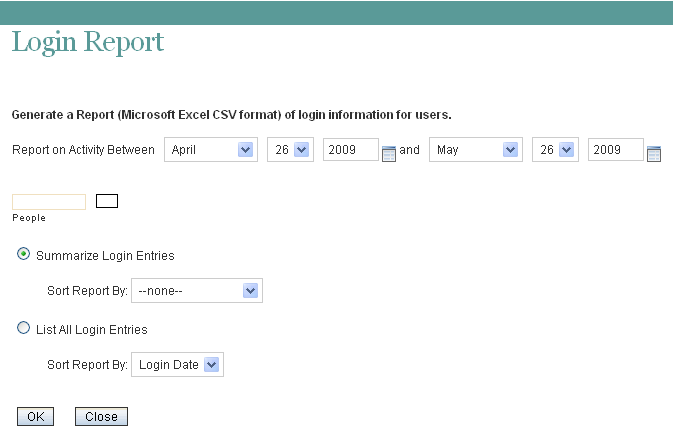
-
Specify the date range for the Login report.
-
Leave the field blank to list all user logins.
or
-
In the field:
-
Select the type of User Activity report that you want to generate.
Summarize Login Entries: Lists how many times the selected users have logged into the Teaming site. In the drop-down list, select , , or to organize the data most helpfully.
List All Login Entries: Lists each individual user login and includes the following data about the action:
-
First name
-
Last name
-
Username
-
Date
-
Time
In the drop-down list, select or to organize the data most helpfully.
-
-
Click to generate the Login report.
-
Select a text editor to view the report in, then click .
For a short report, you might obtain the information you need by viewing the CSV file.
-
(Optional) Save the CSV file with a meaningful name in a convenient location, then retrieve it into a spreadsheet program for further examination.
19.1.2 User Activity Report
The User Activity report lists how many times specified users have viewed, added, modified, or deleted content on the Novell Teaming site during a specified period of time. In addition, it can include the date and time of each action, along with the specific location of the action.
-
Log into the Teaming site as the Teaming administrator.
-
On the Workspace toolbar, click .
-
Expand , then click .
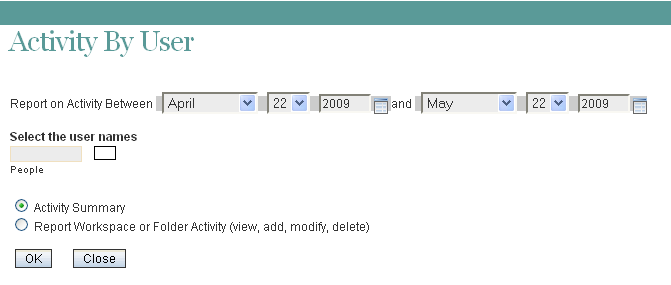
-
Specify the date range for the User Activity report.
-
Leave the field blank to list all user activity.
or
In the field, start typing the first name of a Teaming user.
-
In the drop-down list of names that match what you have typed, select a user whose activity you want to be reported.
-
(Optional) Repeat Step 5 and Step 6 to include additional users.
-
Select the type of User Activity report that you want to generate.
Activity Summary: Lists how many times the selected users have viewed, added, modified, or deleted content on the Teaming site.
Workspace or Folder Activity: Lists each individual user action and includes the following data about the action:
-
User
-
Activity
-
Date
-
Time
-
Folder
-
Entry title
-
Entry type
-
-
Click to generate the User Activity report.
-
Select a text editor to view the report in, then click .
For a short report, you might obtain the information you need by viewing the CSV file.
-
(Optional) Save the CSV file with a meaningful name in a convenient location, then retrieve it into a spreadsheet program for further examination.
19.1.3 User Access Report
The User Access report lists the locations on the Novell Teaming site where a specified user has access rights. In addition, you can view, and if necessary, change or remove the access rights for any location. This report is especially useful on Teaming sites where Guest user access has been granted, as described in Section 4.3, Allowing Guest Access to Your Teaming Site.
-
Log into the Teaming site as the Teaming administrator.
-
On the Workspace toolbar, click .
-
Expand , then click .
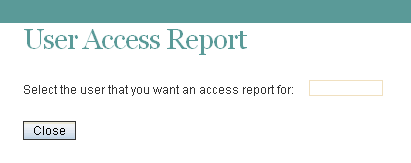
-
Start typing the first name of a Teaming user.
-
In the drop-down list of names that match what you have typed, select the user whose site access you want to be reported.
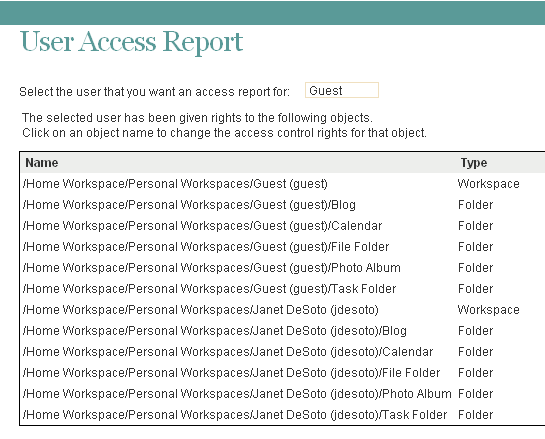
In this example, the Guest user has access to the Guest workspace and also to Janet DeSoto’s personal workspace. This could be appropriate if Janet DeSoto’s job is maintain a publicly available workspace, but would not be appropriate if the Guest access has been granted in error.
-
(Conditional) If you want to change the current access:
-
Click the name of a location to display the Configure Access Control page for that location.
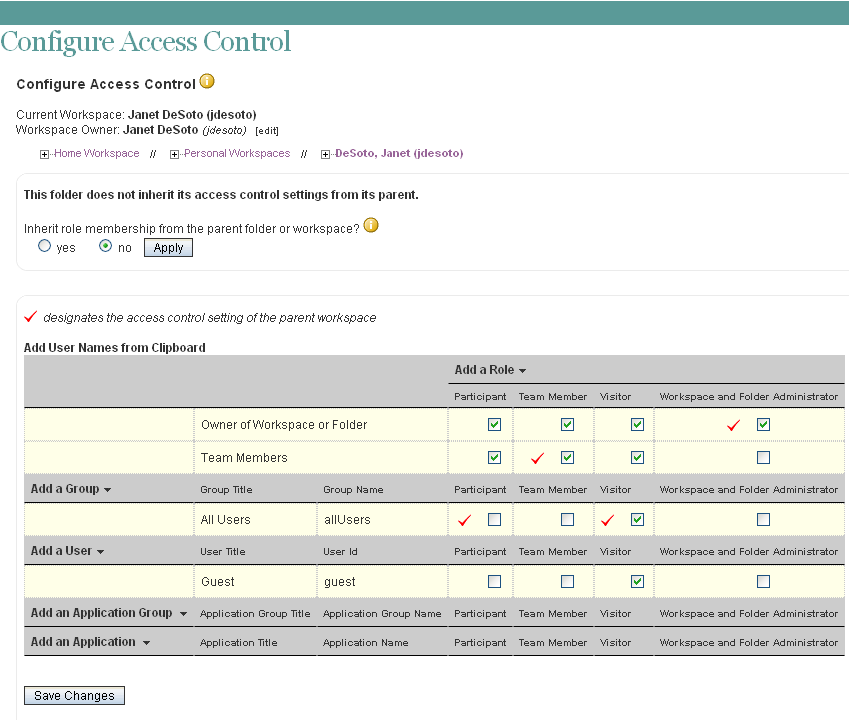
In this example, the Guest user has been granted Visitor access to Janet DeSoto’s personal workspace.
-
Select or deselect access rights as needed.
-
Click , then click to return to the User Access Report page
-
Rerun the report to view the results of your changes.
For example, if you removed the Guest access rights from Janet DeSoto’s personal workspace, her workspace is no longer listed in the User Access report for the Guest user.
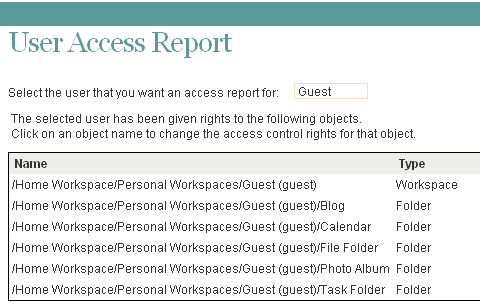
-
-
(Conditional) If you want to save the user access information, you can block and copy it into a text editor.
-
Click when you are finished checking user access rights.
19.1.4 Content Modification Report
The Content Modification report lists changes to workspaces, folders, and folder entries, as well as users, groups, access rights, and workflows. By generating a Content Modification report, you can determine who has performed any of the following actions:
-
Added, modified, moved, or deleted a workspace
-
Added, modified, moved, or deleted a folder
-
Added, modified, renamed, or deleted a file or one of its versions
-
Added, modified, moved, or deleted an entry
For purposes of this report, users and groups are handled as if they are folder entries.
-
Started or modified a workflow
-
Modified or deleted access rights
The Content Modification report can also help you recover data that has been accidentally deleted.
-
Log into the Teaming site as the Teaming administrator.
-
Determine the exact name of the workspace, folder, file entry, and so on where you want to check for content modifications.
-
On the Workspace toolbar, click .
-
Expand , then click .
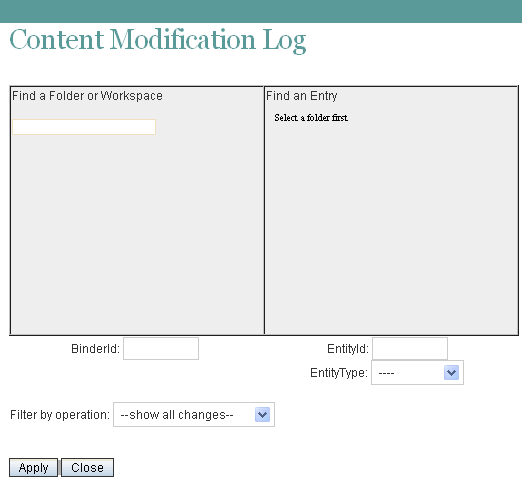
-
Fill in the fields to specify where to check for content modifications and the type of modifications to check for:
Find a Folder or Workspace: Start typing the name of a folder or workspace. In the drop-down list of names that match what you have typed, select the folder or workspace where you want to check for content modifications. The internal ID of the folder or workspace is displayed for reference.
Find an Entry: (Optional) To restrict the content modification check to a specific entry in a folder, start typing text in the title of the entry. In the drop-down list of entry titles that match what you have typed, select the entry where you want to check for content modifications. The internal ID of the entry is displayed for reference.
Entity Type: (Optional) To further restrict the content modification check, select one of the following:
-
Workspace (not the contents of the workspace, but the workspace itself)
-
Folder (not the contents of the folder, but the folder itself)
-
Folder entry (the contents of the folder entry)
-
Profiles (the contents of the Personal Workspaces folder where there is a personal workspace for each user)
-
User (the contents of a user’s personal profile, such as the user’s name, e-mail address, locale, and so on)
-
Group (the contents of the group)
Filter by Operation: Further restrict the content modification check by selecting a specific action performed on the selected workspace, folder, or entry (add, modify, rename, delete, and so on).
-
-
Click to generate the Content Modification report.
The results are displayed as an XML file.
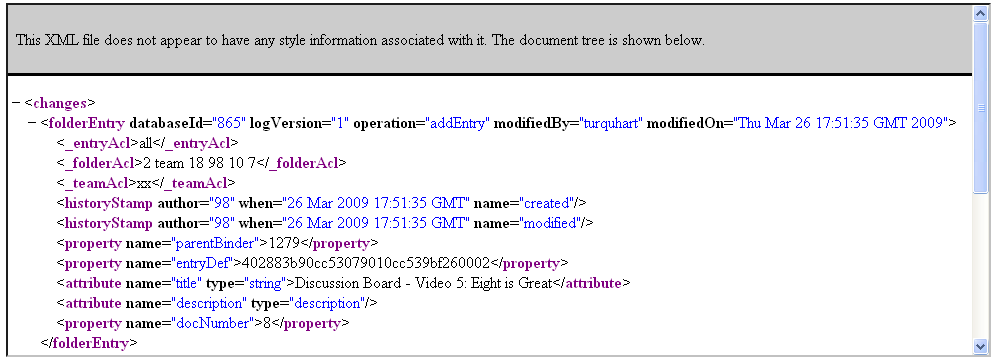
-
(Conditional) If the results are too extensive, restrict the scope of the content modification check until you locate the modification that you are seeking.
-
Click when you are finished checking for content modifications.
A specialized use of the Content Modification report is to restore accidentally deleted data. For example, you can use the following steps to recover an accidentally deleted folder entry:
-
Run the Content Modification report to list all entry deletions in the folder where the entry was accidentally deleted.
-
Record the entry ID of the deleted entry.
-
Run the Content Modification report on the entry ID, selecting in the field.
-
Use the modification history of the entry to reconstruct the accidentally deleted entry.
19.1.5 Disk Usage Report
The Disk Usage report lists the amount of disk space for workspaces on the Novell Teaming site by user, by workspace, or by both. In addition, you can restrict the reporting to only those workspaces that exceed a specified number of megabytes.
-
Log into the Teaming site as the Teaming administrator.
-
On the Workspace toolbar, click .
-
Expand , then click .
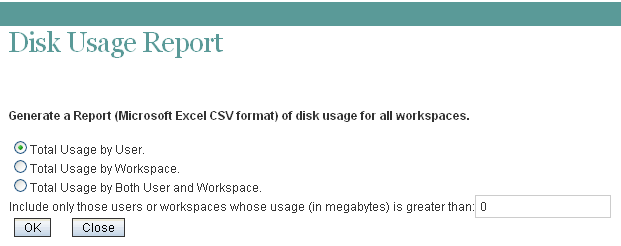
-
Select the type of Disk Usage report that you want to generate.
Total Usage by User: Lists all Teaming users whose disk space usage is above the amount specified in the field.
Total Usage by Workspace: Lists all workspaces where disk space usage is above the amount specified in the field. Disk space usage for each folder in each workspace is listed separately. The data is organized by workspace and folder ID.
Total Usage by Both User and Workspace: Combines the user and workspace data into a single report.
Usage Greater Than: Specify the number of megabytes above which you want to list disk space usage. This eliminates smaller disk space usages from the report.
-
Click to generate the Disk Usage report.
-
Select a text editor to view the report in, then click .
For a short report, you might obtain the information you need by viewing the CSV file.
-
(Optional) Save the CSV file with a meaningful name in a convenient location, then retrieve it into a spreadsheet program for further examination.
-
Click when you are finished checking disk space usage.
19.1.6 License Report
The License report lists the amount of disk space for workspaces on the Novell Teaming site by user, by workspace, or by both. In addition, you can restrict the reporting to only those workspaces that exceed a specified number of megabytes.
-
Log into the Teaming site as the Teaming administrator.
-
On the Workspace toolbar, click .
-
Expand , then click .

-
Specify the date range for the Login report, then click .
The License report lists the following information:
-
Teaming version
-
License key type
-
Date the license key was issued
-
Date range when the license key is valid
-
Maximum number of logged-in users during the date range (high-water mark)
-
Current user count
-
List of dates in the date range with the number of local users and number of users synchronized from LDAP.
The Teaming software does not limit the number of Teaming users that you can create, but sites where Teaming licenses have been purchased and the Teaming software installed are periodically audited against their purchased number of licenses.
The Guest user feature described in Section 4.3, Allowing Guest Access to Your Teaming Site has its own license. If you originally installed a basic Teaming system, then added the Guest feature, two licenses are listed. If you originally installed with the Guest feature license, only that license is listed. The Guest feature license includes all other standard Teaming functionality. The Guest user counts as one user license, regardless of how many people log in to the Teaming site as Guest.
-
-
Click when you are finished reviewing the License report.
For instructions to install a new Teaming license, see Updating Your Teaming License
in Basic Installation
in the Novell Teaming 2.0 Installation Guide.